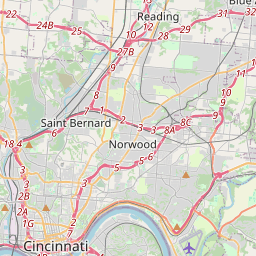Dr. Alfred Buckingham
Historical marker location:
Camp Dennison, Ohio
( Marker is at the intersection of Glendale - Milford Road and Galbraith Road on Glendale - Milford Road.)






© OpenStreetMap contributors
Loading...
Searching for other points of interest within 3 miles of this location.Ohio is known as the "Mother of Presidents" because of its role in producing so many US presidents. In addition to the seven presidents who were born in Ohio, another president, William Henry Harrison, lived in Ohio for much of his life and is sometimes counted as an honorary Ohioan.
About Hamilton County
Hamilton County Timeline
Hamilton County, Ohio, located in the southwestern part of the state, has a rich and diverse history that spans centuries. The area was originally inhabited by Native American tribes, including the Shawnee and Miami, who lived off the fertile land along the Ohio River. In the late 18th century, European settlers arrived and established small communities along the river, attracted by the area's agricultural potential and access to transportation.
In 1790, Hamilton County was officially organized, named after Alexander Hamilton, one of the founding fathers of the United States and the first Secretary of the Treasury. Cincinnati, the county seat, was quickly established as a bustling town and became an important trading hub due to its location on the Ohio River. The region prospered throughout the 19th century, fueled by the growth of the steamboat industry and the expansion of canals and railroads.
During the Civil War, Hamilton County played a significant role as a major recruiting and training ground for Union soldiers. The area experienced economic growth during this time, as factories producing war-related goods saw increased demand. In the early 20th century, industries such as manufacturing, steel, and Procter & Gamble's consumer products further propelled the county's development.
Hamilton County has also faced challenges throughout its history. In the mid-20th century, urban decline and suburbanization led to economic challenges and population loss in some parts of the county. However, efforts have been made to revitalize urban areas and preserve historic sites, leading to renewed interest in the county's past.
Today, Hamilton County is a vibrant and diverse community, with a mix of urban and suburban areas. It is known for its cultural attractions, including the Cincinnati Zoo, Cincinnati Art Museum, and the iconic Over-the-Rhine neighborhood. The county continues to grow and adapt, preserving its history while embracing new opportunities for progress and development.
In 1790, Hamilton County was officially organized, named after Alexander Hamilton, one of the founding fathers of the United States and the first Secretary of the Treasury. Cincinnati, the county seat, was quickly established as a bustling town and became an important trading hub due to its location on the Ohio River. The region prospered throughout the 19th century, fueled by the growth of the steamboat industry and the expansion of canals and railroads.
During the Civil War, Hamilton County played a significant role as a major recruiting and training ground for Union soldiers. The area experienced economic growth during this time, as factories producing war-related goods saw increased demand. In the early 20th century, industries such as manufacturing, steel, and Procter & Gamble's consumer products further propelled the county's development.
Hamilton County has also faced challenges throughout its history. In the mid-20th century, urban decline and suburbanization led to economic challenges and population loss in some parts of the county. However, efforts have been made to revitalize urban areas and preserve historic sites, leading to renewed interest in the county's past.
Today, Hamilton County is a vibrant and diverse community, with a mix of urban and suburban areas. It is known for its cultural attractions, including the Cincinnati Zoo, Cincinnati Art Museum, and the iconic Over-the-Rhine neighborhood. The county continues to grow and adapt, preserving its history while embracing new opportunities for progress and development.
Hamilton County Timeline
This timeline provides a concise overview of the key events in the history of Hamilton County, Ohio.
- 1790: Hamilton County was established on January 2.
- 1803: The first courthouse was built in Cincinnati.
- 1808: The city of Cincinnati was incorporated as a town on January 1.
- 1819: The Cincinnati Observatory, the oldest professional observatory in the United States, was founded.
- 1820: The population of Hamilton County reached 16,230.
- 1828: The Cincinnati Public Library was established as the Young Men's Mercantile Library Association.
- 1850: The population of Hamilton County reached 145,534.
- 1884: The Cincinnati Reds, one of the oldest professional baseball teams in the United States, was founded.
- 1912: Music Hall, a historic concert venue, was opened in Cincinnati.
- 1920: The population of Hamilton County reached 540,153.
- 1963: The Cincinnati Reds won the World Series.
- 2001: Paul Brown Stadium, home to the Cincinnati Bengals, opened.